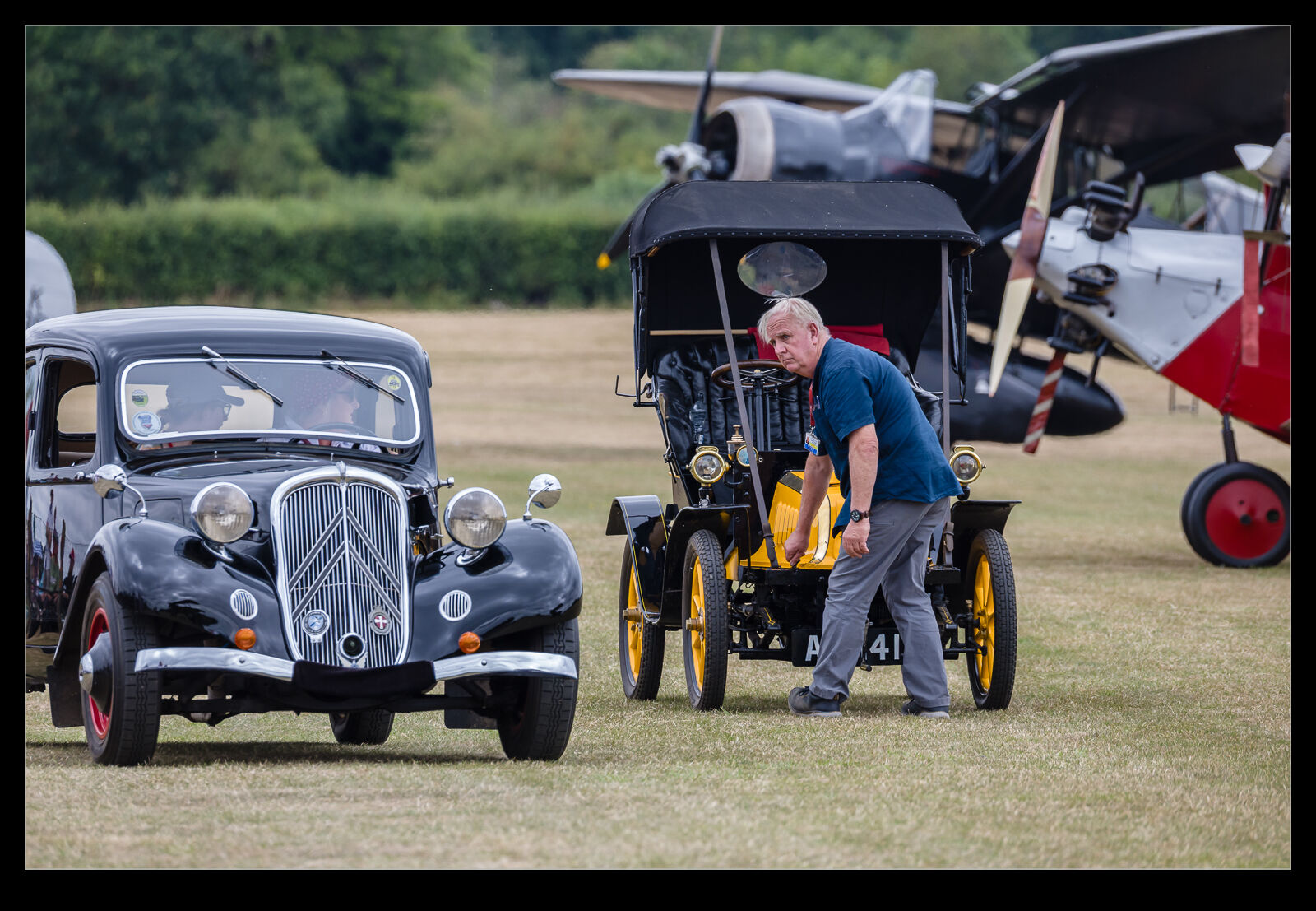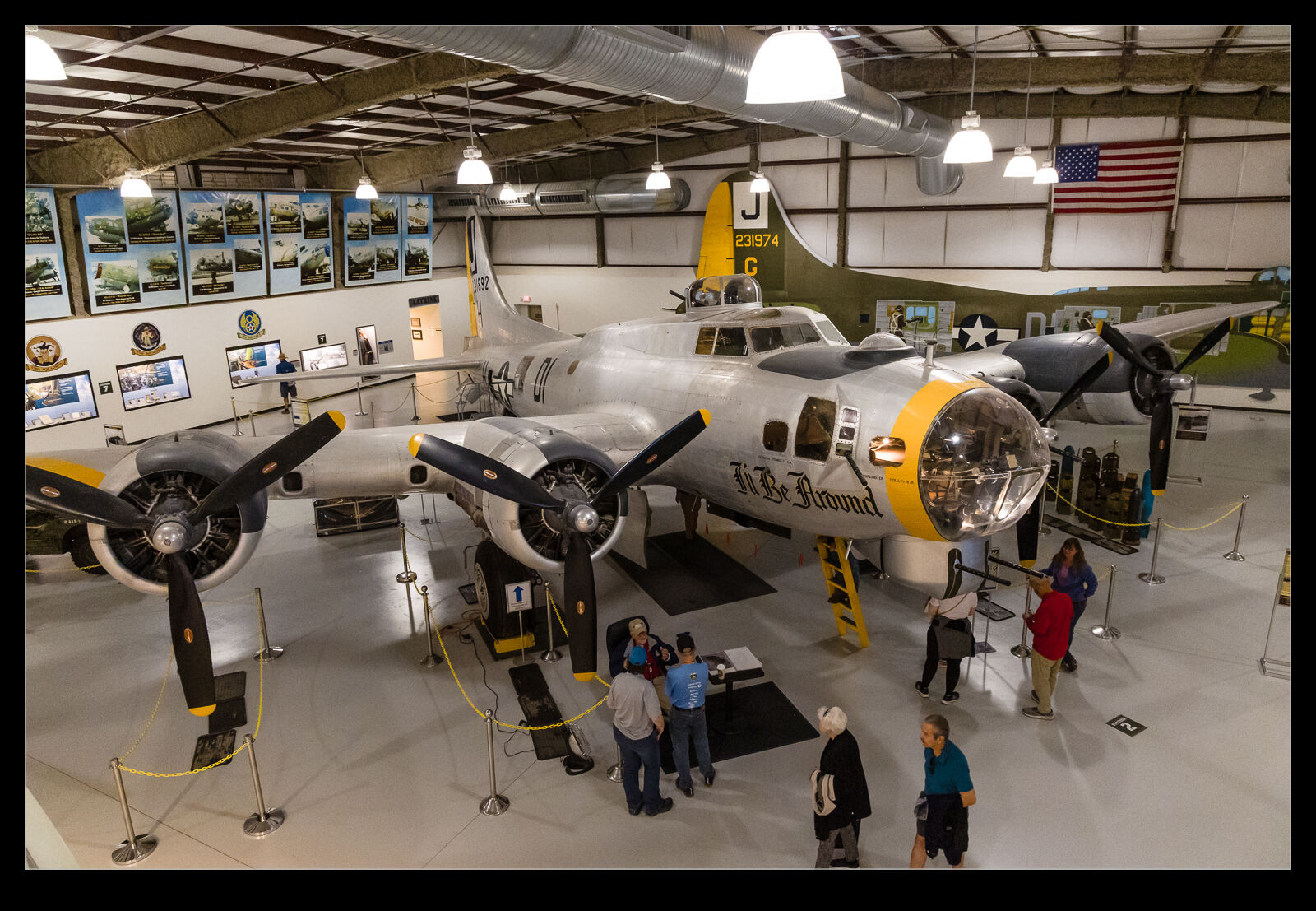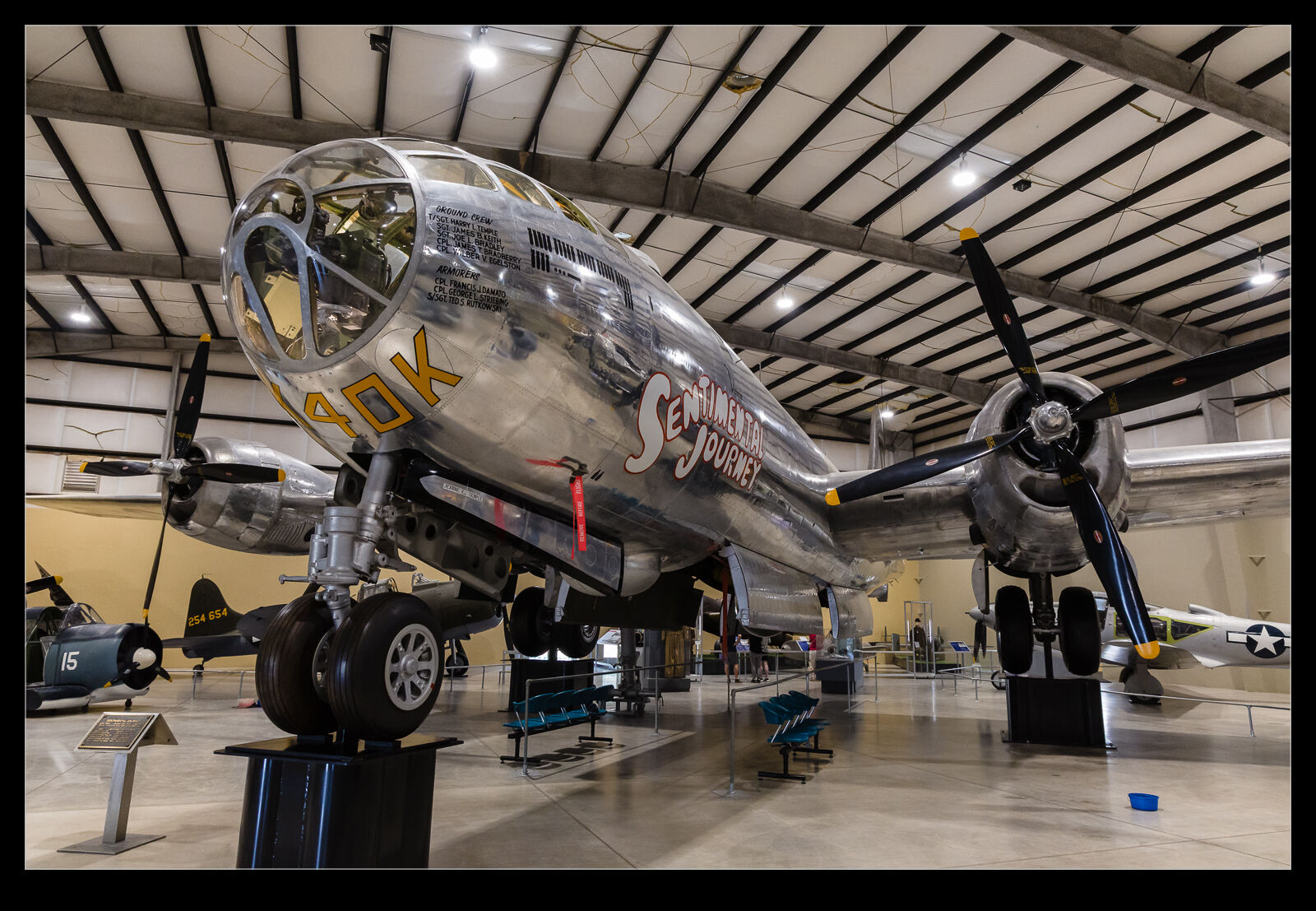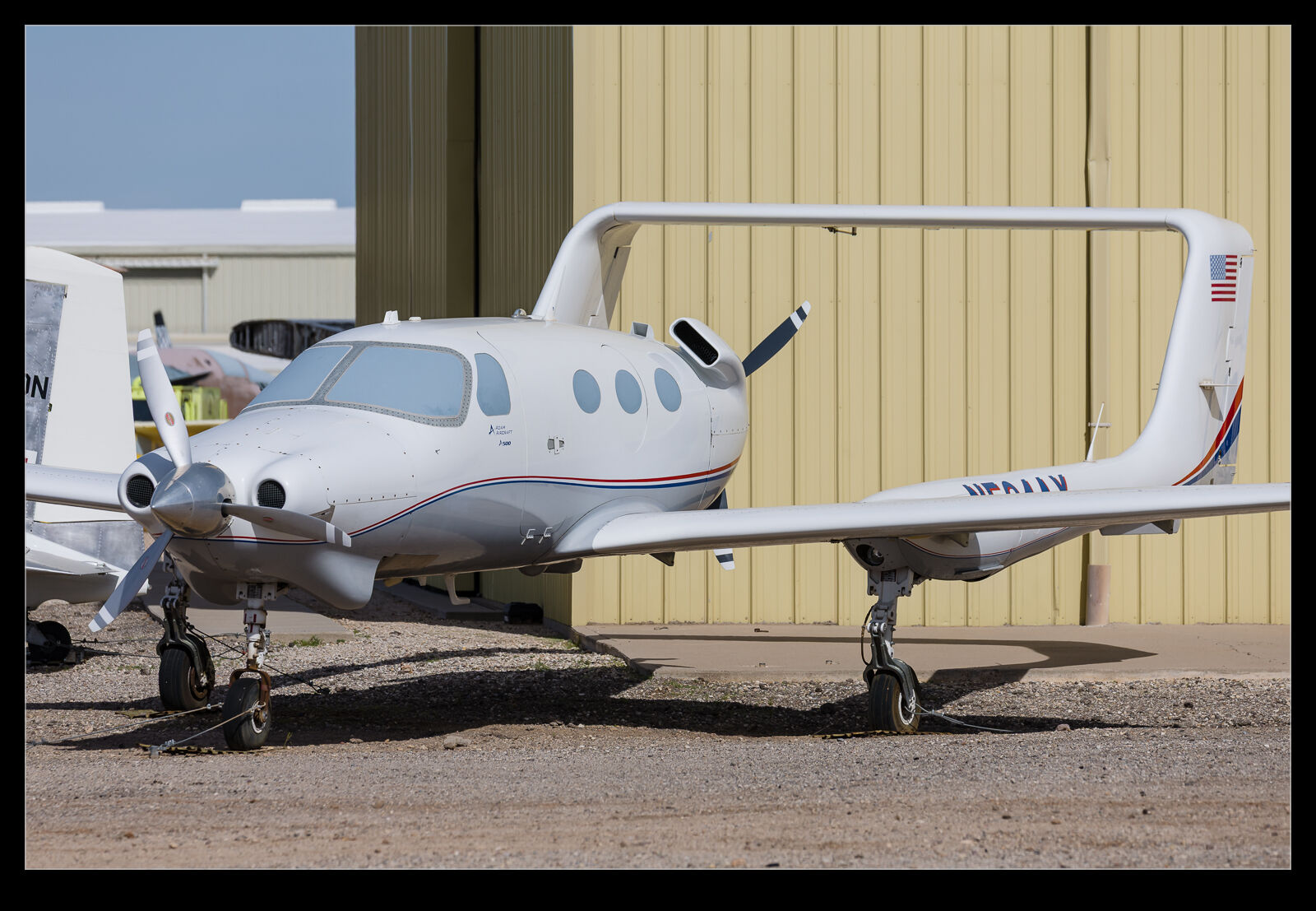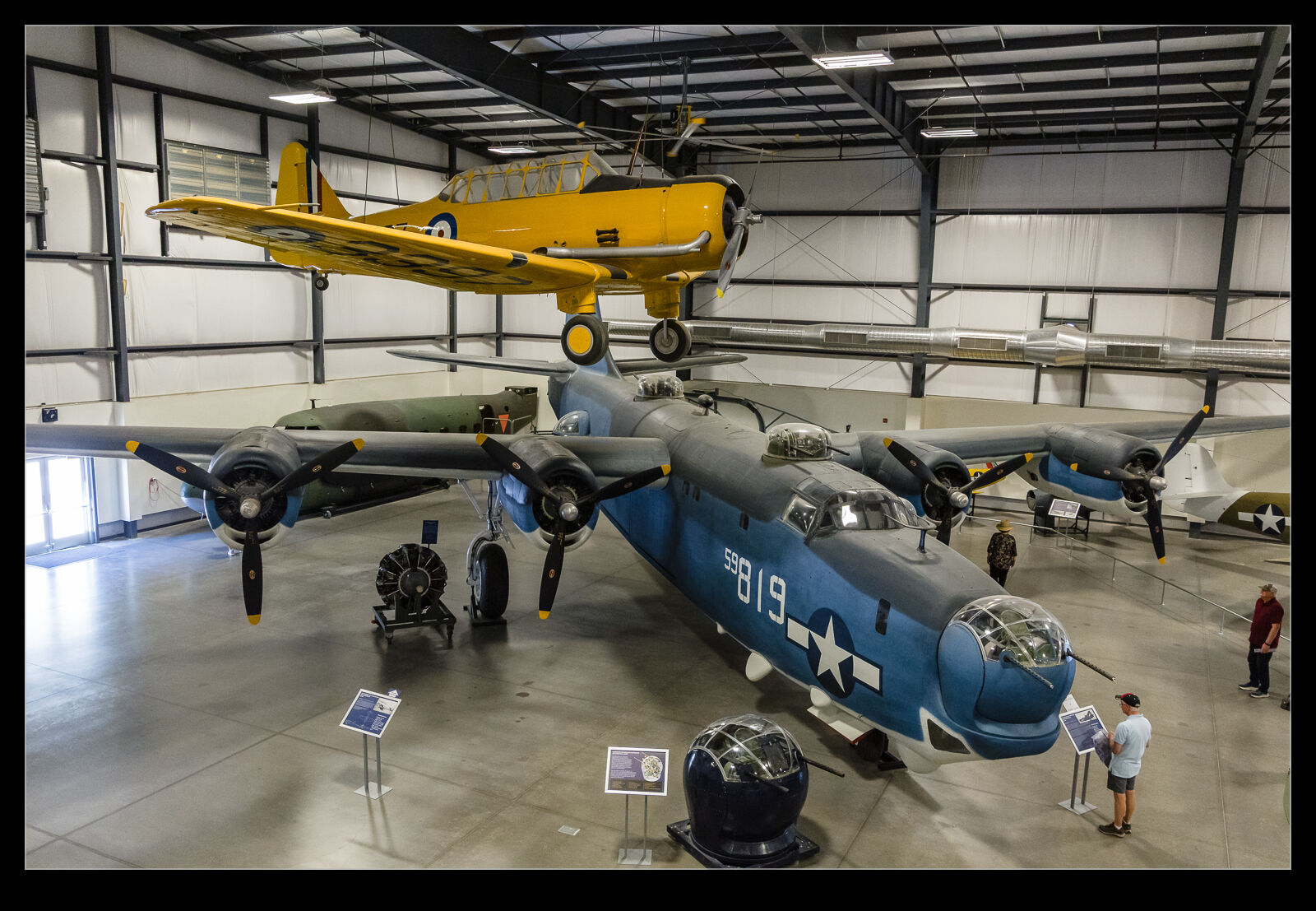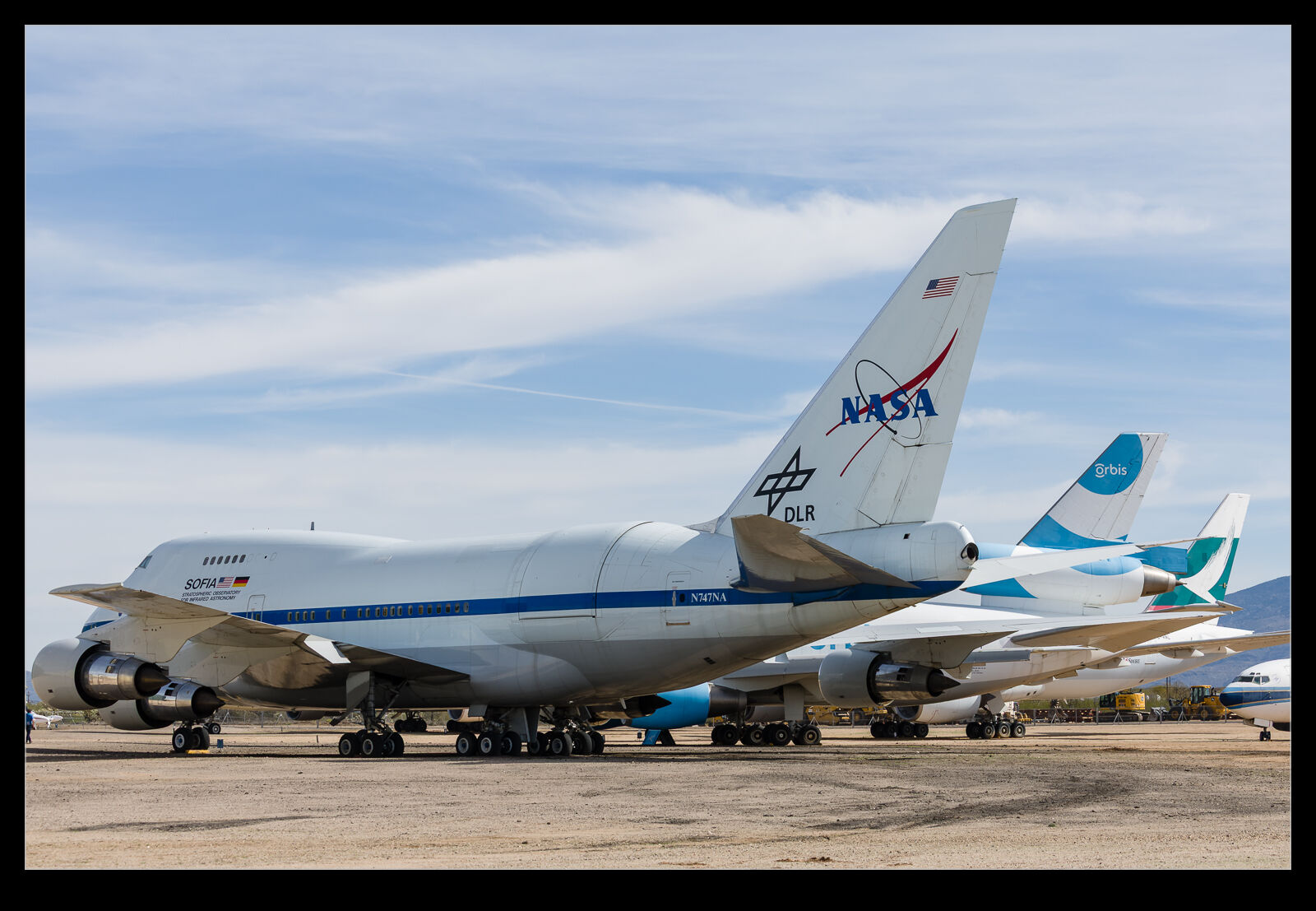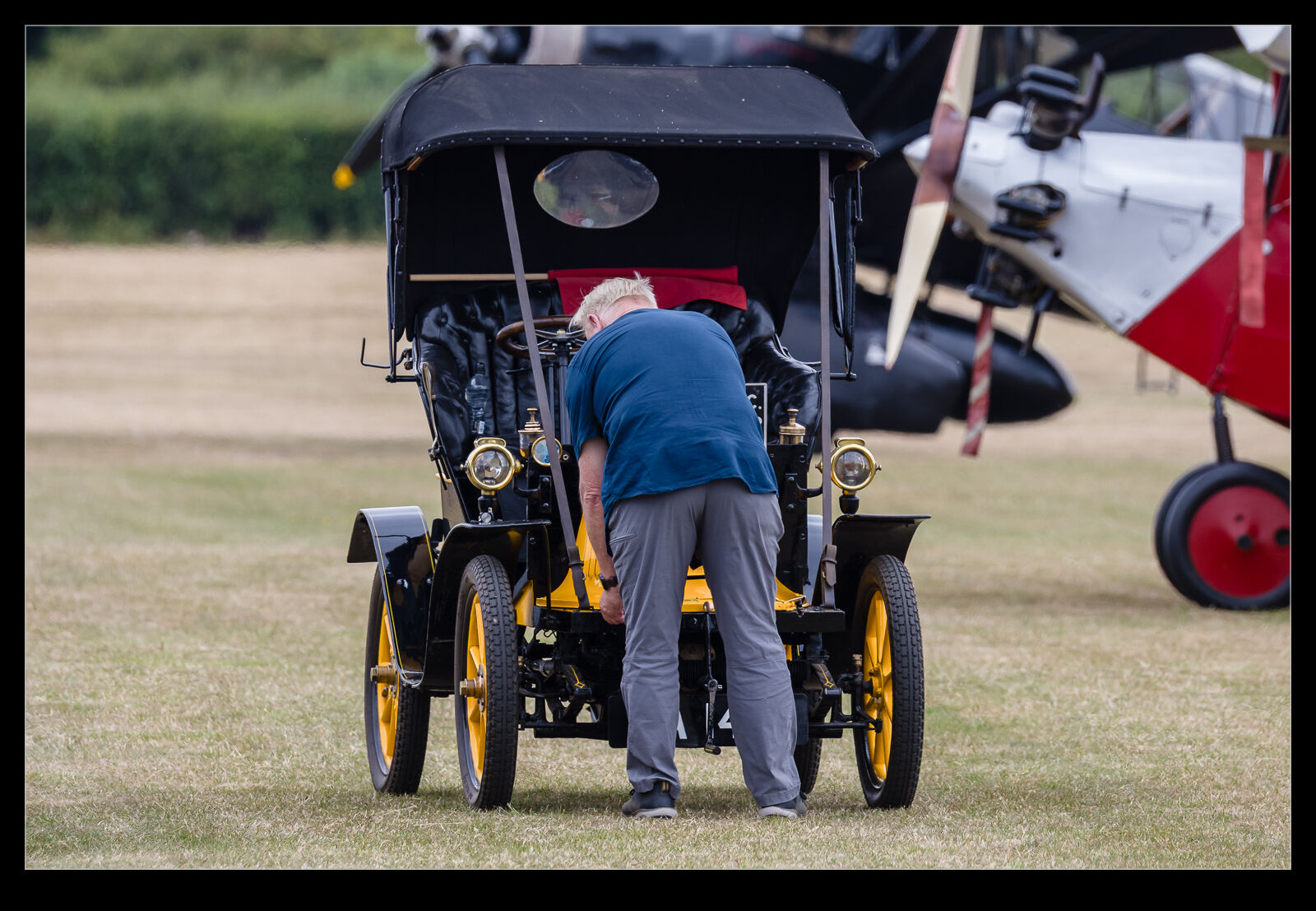 There was a parade of old cars as part of the Festival of Flight at the Shuttleworth Trust. It was a very hot day so possibly not ideal for cars that were designed a very long time ago. Sadly, one of the vehicles found the conditions not to its liking. The driver had to hop out and see what could be done to sort it out. There didn’t seem to be an immediate solution as, the last I saw of it, a bunch of people were pushing it away. I hope it was nothing too serious. I suspect owning a car this old comes with regular moments of this type.
There was a parade of old cars as part of the Festival of Flight at the Shuttleworth Trust. It was a very hot day so possibly not ideal for cars that were designed a very long time ago. Sadly, one of the vehicles found the conditions not to its liking. The driver had to hop out and see what could be done to sort it out. There didn’t seem to be an immediate solution as, the last I saw of it, a bunch of people were pushing it away. I hope it was nothing too serious. I suspect owning a car this old comes with regular moments of this type.
Tag Archives: vintage
A Grumman Goose Joins the Party
 The Martin Mars was the reason we had made the trip to Sproat Lake last year, but it wasn’t the only flying boat we got. At one point, when we were on the dock rather than out on the water, the rumble of engines came to us. We wondered what it might be but didn’t have to wait long to find out. A Grumman Goose came over the top and headed off to land on the water. We were hoping that it might fly around a bit and maybe come over along with the Mars but that wasn’t to be. Just a quick encounter and that was it.
The Martin Mars was the reason we had made the trip to Sproat Lake last year, but it wasn’t the only flying boat we got. At one point, when we were on the dock rather than out on the water, the rumble of engines came to us. We wondered what it might be but didn’t have to wait long to find out. A Grumman Goose came over the top and headed off to land on the water. We were hoping that it might fly around a bit and maybe come over along with the Mars but that wasn’t to be. Just a quick encounter and that was it.
Severn Valley Railway at Kidderminster
 2025 is the 200th anniversary of the first passenger railways in the world and the UK is celebrating this throughout the year with the Rail200 events. Our company is supporting this at a few events including a weekend at the Severn Valley Railway in Kidderminster. I volunteered to take part in this event so spent a couple of days showing people around our hydrogen fuel cell demonstrator train. More of that in a separate post.
2025 is the 200th anniversary of the first passenger railways in the world and the UK is celebrating this throughout the year with the Rail200 events. Our company is supporting this at a few events including a weekend at the Severn Valley Railway in Kidderminster. I volunteered to take part in this event so spent a couple of days showing people around our hydrogen fuel cell demonstrator train. More of that in a separate post.
 The Severn Valley station is alongside the mainline station in Kidderminster. I guess you had to walk between the two stations when this line was still a part of the national system. The mainline station is a modern looking affair, but the Severn Valley’s station has a far more period feel to it. Here are some images of the station itself. It will come as no surprise to find out that I shall have more posts to come from the weekend before too long.
The Severn Valley station is alongside the mainline station in Kidderminster. I guess you had to walk between the two stations when this line was still a part of the national system. The mainline station is a modern looking affair, but the Severn Valley’s station has a far more period feel to it. Here are some images of the station itself. It will come as no surprise to find out that I shall have more posts to come from the weekend before too long.
An Unusual Pairing for “Formations”
 In the late 1980s, the RAF had just introduced the Tornado ADV to service. The squadron boss of the OCU displayed the jet with a Spitfire of the BBMF. This dissimilar formation caught my attention at the time. This was repeated in the 2000s when the RAF repeated the idea with a Typhoon and Spitfire display. However, I think I saw something that trumped both of those combinations at the Shuttleworth Military Air Show. The combination of a Great War SE5a and Spitfire was really something else. You might think that a fast jet and a Spitfire is a tough combination, but jets can fly slowly quite well, and Spitfires are no slouch.
In the late 1980s, the RAF had just introduced the Tornado ADV to service. The squadron boss of the OCU displayed the jet with a Spitfire of the BBMF. This dissimilar formation caught my attention at the time. This was repeated in the 2000s when the RAF repeated the idea with a Typhoon and Spitfire display. However, I think I saw something that trumped both of those combinations at the Shuttleworth Military Air Show. The combination of a Great War SE5a and Spitfire was really something else. You might think that a fast jet and a Spitfire is a tough combination, but jets can fly slowly quite well, and Spitfires are no slouch.
 However, an SE5a is not a speedy plane while a Spitfire is still no slouch! How to make this work then? Some very clever use of speed differentials and spacing is the answer. The SE5a would fly some curving passes closer to the crowd line while the Spitfire offset further out – slowing into the pass and then accelerating away. The result is a view from the crowd where both planes are quite well aligned.
However, an SE5a is not a speedy plane while a Spitfire is still no slouch! How to make this work then? Some very clever use of speed differentials and spacing is the answer. The SE5a would fly some curving passes closer to the crowd line while the Spitfire offset further out – slowing into the pass and then accelerating away. The result is a view from the crowd where both planes are quite well aligned.
 The idea was very interesting. I won’t say it is innovative because I’m sure someone has done something like this before, but it was the first time I had seen it. The result was surprisingly effective, and they did it on a few passes. I don’t know just how precise the initial points have to be and how much scope the pilots have to adjust on the run in to make it work. I assume the SE5a pilot just flies the pass, and the Spitfire pilot has the power and control to make the adjustments. Whatever the approach, it worked well.
The idea was very interesting. I won’t say it is innovative because I’m sure someone has done something like this before, but it was the first time I had seen it. The result was surprisingly effective, and they did it on a few passes. I don’t know just how precise the initial points have to be and how much scope the pilots have to adjust on the run in to make it work. I assume the SE5a pilot just flies the pass, and the Spitfire pilot has the power and control to make the adjustments. Whatever the approach, it worked well.
Pima the Following Day
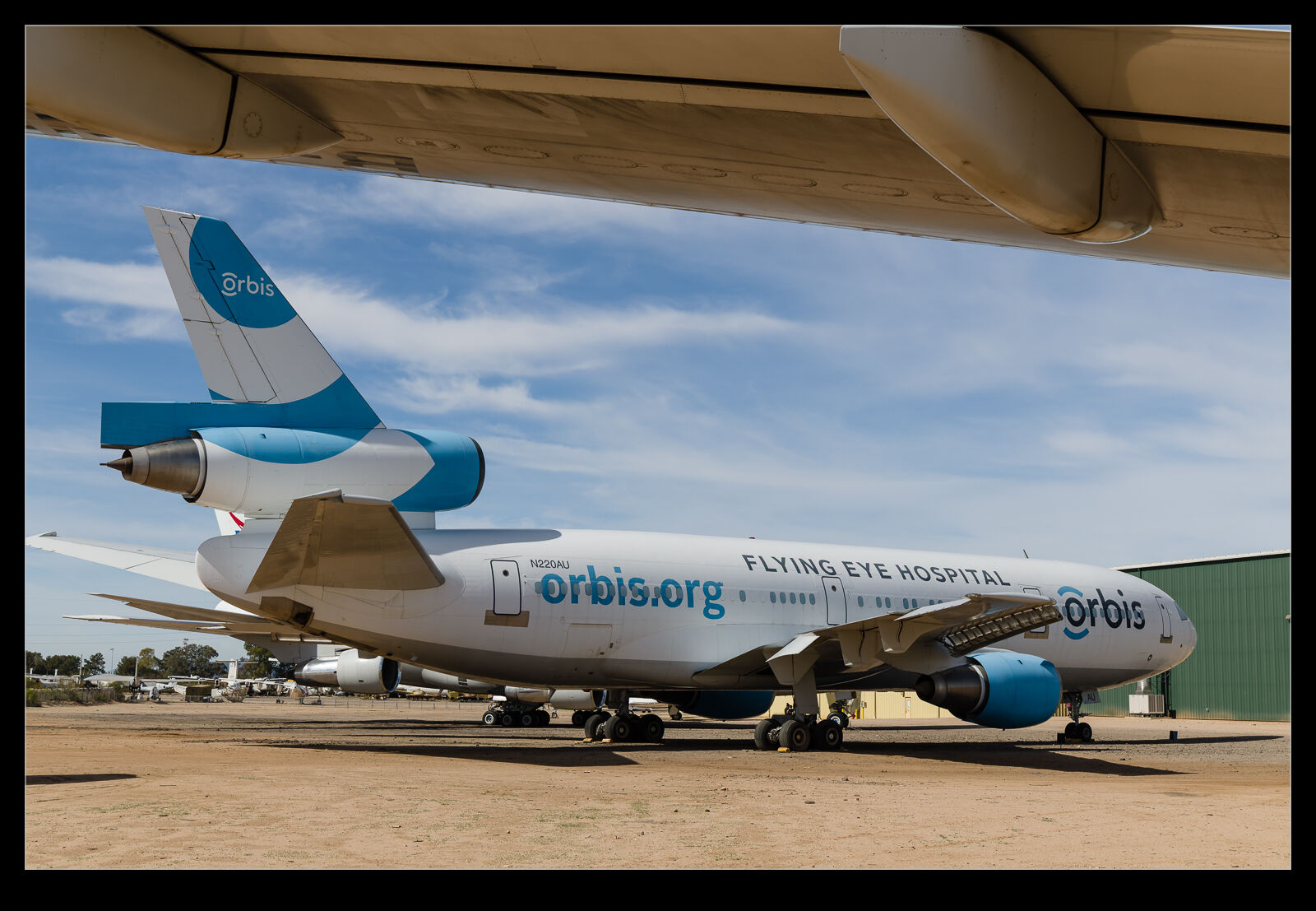 A bit of a step back for today’s post. This one goes back to early ’24 when Mark and I were in Arizona. We had done a night shoot at the Pima museum the evening before courtesy of our friend Joe. We decided to head back during the following day to see everything in daylight. Despite being early in the year, the temperatures were pretty high and there was a limit to how much I could handle outside. I did get a few different subjects but then it was time to retreat to the hangars to get out of the sun.
A bit of a step back for today’s post. This one goes back to early ’24 when Mark and I were in Arizona. We had done a night shoot at the Pima museum the evening before courtesy of our friend Joe. We decided to head back during the following day to see everything in daylight. Despite being early in the year, the temperatures were pretty high and there was a limit to how much I could handle outside. I did get a few different subjects but then it was time to retreat to the hangars to get out of the sun.
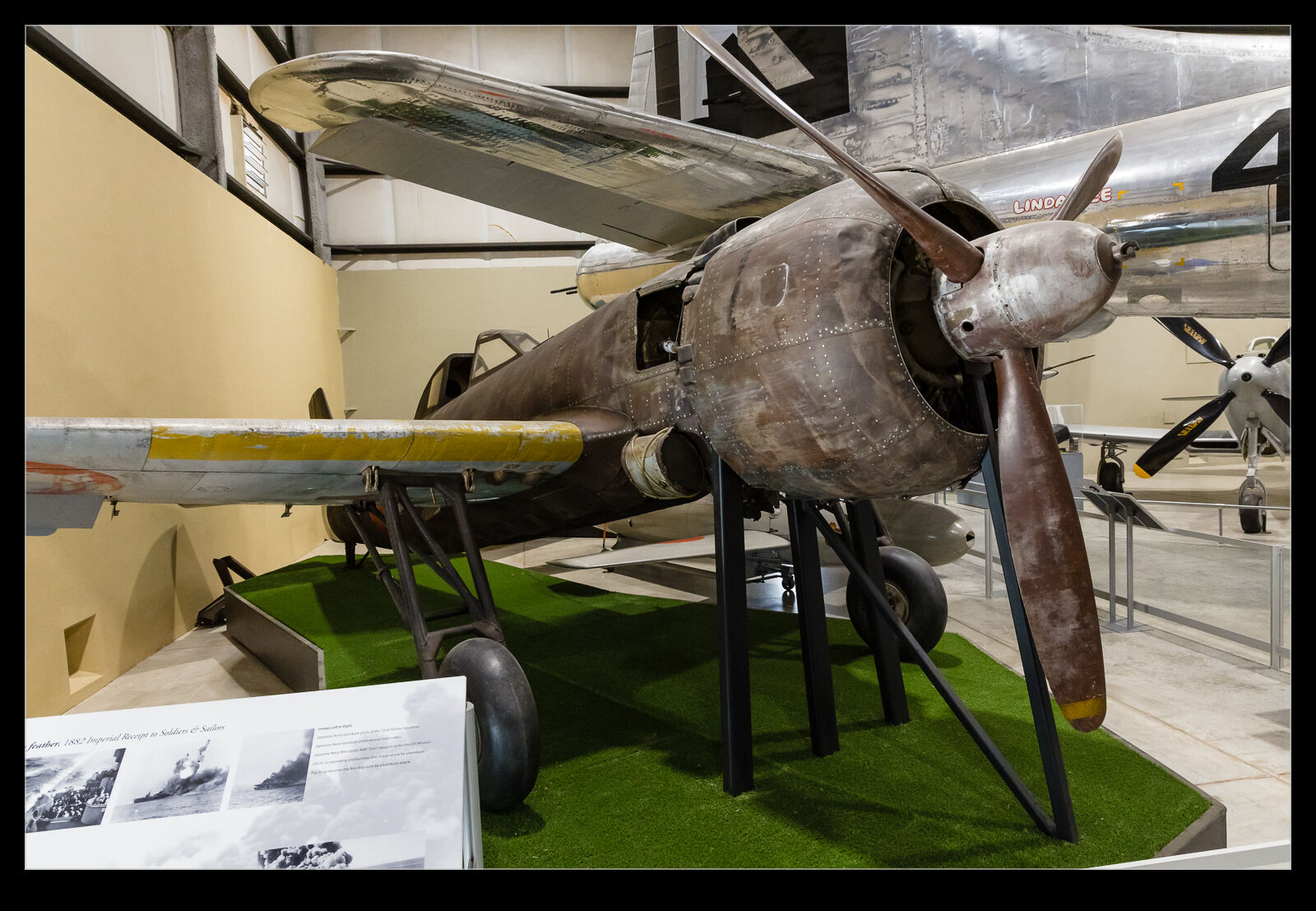 The museum was more extensive than I recall from my original visit years ago. I don’t know whether the hangars had all been added since I last visited or I had just not realised what I was missing. Whatever the reason, there was plenty to see. The variety of exhibits is just amazing. Whether it is vintage fighters, old civil aircraft or widebody jets, there is something there for any speciality. The strength of the collection makes it possible for them to get all sorts of exhibits, and their space means that can be of any size. Recently, they have taken delivery of a Martin Mars flying boat, for example. No small task when you aren’t too close to any water!
The museum was more extensive than I recall from my original visit years ago. I don’t know whether the hangars had all been added since I last visited or I had just not realised what I was missing. Whatever the reason, there was plenty to see. The variety of exhibits is just amazing. Whether it is vintage fighters, old civil aircraft or widebody jets, there is something there for any speciality. The strength of the collection makes it possible for them to get all sorts of exhibits, and their space means that can be of any size. Recently, they have taken delivery of a Martin Mars flying boat, for example. No small task when you aren’t too close to any water!
My First Shuttleworth Show
 For someone that is a keen aviation enthusiast, it is very strange that I have only been to the Shuttleworth Collection at Old Warden once and that was a quiet weekend day in the late 80s. I have never been to a show until now. They were holding their Military Air Show, and I wanted to be there. I had heard that the flying could be good with a display line that is close to the crowd and an interesting variety of planes taking part. I headed up there on the Saturday morning and was a little disappointed that there was an accident closing the A-1 so I had a slightly cross-country route to get there. However, this didn’t really cause a problematic delay.
For someone that is a keen aviation enthusiast, it is very strange that I have only been to the Shuttleworth Collection at Old Warden once and that was a quiet weekend day in the late 80s. I have never been to a show until now. They were holding their Military Air Show, and I wanted to be there. I had heard that the flying could be good with a display line that is close to the crowd and an interesting variety of planes taking part. I headed up there on the Saturday morning and was a little disappointed that there was an accident closing the A-1 so I had a slightly cross-country route to get there. However, this didn’t really cause a problematic delay.
 When I got there, I parked up and was pleasantly surprised how easy the walk was to the main area of the show. Not only was it not a long walk but it was alongside the main runway, so I got to watch some movements as I headed in. It was like the show had already started before I even got there. It is true that this meant my walk took longer than it should have done but this was good for me.
When I got there, I parked up and was pleasantly surprised how easy the walk was to the main area of the show. Not only was it not a long walk but it was alongside the main runway, so I got to watch some movements as I headed in. It was like the show had already started before I even got there. It is true that this meant my walk took longer than it should have done but this was good for me.
 When I was young, my interest was all about modern aviation so the types of planes that were at this show would not have been my thing. Now I am interested in a far wider range of subjects. However, that doesn’t mean I am very knowledgeable about them. First World War aviation is a bit of a mystery to me. This show got me familiar with types that I might have heard about but could never have previously picked out.
When I was young, my interest was all about modern aviation so the types of planes that were at this show would not have been my thing. Now I am interested in a far wider range of subjects. However, that doesn’t mean I am very knowledgeable about them. First World War aviation is a bit of a mystery to me. This show got me familiar with types that I might have heard about but could never have previously picked out.
 While it was a show with a military focus, there were other types taking part. Sometimes there might be a slightly tangential reference to their role in developing other planes as was the case when the de Havilland Comet took part, but I appreciated the variety. There were planes I knew nothing about in the flying display – some of which were unique examples. With so many shows including displays by types I have seen many times, this was a definite plus.
While it was a show with a military focus, there were other types taking part. Sometimes there might be a slightly tangential reference to their role in developing other planes as was the case when the de Havilland Comet took part, but I appreciated the variety. There were planes I knew nothing about in the flying display – some of which were unique examples. With so many shows including displays by types I have seen many times, this was a definite plus.
 The conditions were pretty good for the show with good light throughout most of the day. We did get a period when the clouds got a little heavier and some of the dark paint on those older planes can really suck in the light. The bigger concern was the wind. It was a rather gusty day on occasions. This had me a little concerned. There were actually two flying displays. The afternoon display and an evening show. If the wind would play ball, this might be the time that the Edwardian aircraft could come out. More of that on another day’s post.
The conditions were pretty good for the show with good light throughout most of the day. We did get a period when the clouds got a little heavier and some of the dark paint on those older planes can really suck in the light. The bigger concern was the wind. It was a rather gusty day on occasions. This had me a little concerned. There were actually two flying displays. The afternoon display and an evening show. If the wind would play ball, this might be the time that the Edwardian aircraft could come out. More of that on another day’s post.
 Between the afternoon and evening displays, I finally took time to walk around the grounds. I hadn’t paid to go and see the house and I shall probably do that at some point in the future. However, I did now go and look through the aircraft parked up on the flight line and the infield. There are also the hangars for the collection. This had grown substantially from what I saw when I was last there in the 80s! The collection would definitely fit the term eclectic!
Between the afternoon and evening displays, I finally took time to walk around the grounds. I hadn’t paid to go and see the house and I shall probably do that at some point in the future. However, I did now go and look through the aircraft parked up on the flight line and the infield. There are also the hangars for the collection. This had grown substantially from what I saw when I was last there in the 80s! The collection would definitely fit the term eclectic!
 It was funny watching a flying display when the Spitfires would be considered the modern aircraft. A recalibration of what constitutes an old aircraft for sure. The evening light did work out pretty well. For some of the later displays, the sun had crept under the cloud layer to make for some nice photography conditions. With it being summer, the flying could last late into the evening. It meant it was well into the night by the time I got home. It was well worth doing. Thanks also to Chris and his friends for providing good company throughout the day.
It was funny watching a flying display when the Spitfires would be considered the modern aircraft. A recalibration of what constitutes an old aircraft for sure. The evening light did work out pretty well. For some of the later displays, the sun had crept under the cloud layer to make for some nice photography conditions. With it being summer, the flying could last late into the evening. It meant it was well into the night by the time I got home. It was well worth doing. Thanks also to Chris and his friends for providing good company throughout the day.
National Railway Museum
 I was fortunate a little while ago to have a tour of the National Railway Museum. Our company had sponsored some of the development at the museum and we were invited to come and see some of the parts of the museum that are normally out of sight to the regular visitors. This was a most interesting visit, and our team really appreciated the time there. This was actually the first time I had been to this excellent museum.
I was fortunate a little while ago to have a tour of the National Railway Museum. Our company had sponsored some of the development at the museum and we were invited to come and see some of the parts of the museum that are normally out of sight to the regular visitors. This was a most interesting visit, and our team really appreciated the time there. This was actually the first time I had been to this excellent museum.
 As part of the Science Museum, the National Railway Museum is free to the public. They are expanding the facilities a lot currently but, if you were to visit now, you would still have plenty to see. There are trains of all types and age. The main hall is focused on a turntable. Apparently, the collection does get moved regularly so what you see at any one time can vary.
As part of the Science Museum, the National Railway Museum is free to the public. They are expanding the facilities a lot currently but, if you were to visit now, you would still have plenty to see. There are trains of all types and age. The main hall is focused on a turntable. Apparently, the collection does get moved regularly so what you see at any one time can vary.
 The majority of the collection is UK trains but there are other exhibits. A series 0 Shinkansen is part of the collection. Additionally, there is a Eurostar cab vehicle. Some famous locos are there, like Mallard, holder of the steam speed record. There are other less famous ones like the last steam loco built for the UK. I liked seeing the HST power car having had a lot of involvement with that fleet earlier in my career.
The majority of the collection is UK trains but there are other exhibits. A series 0 Shinkansen is part of the collection. Additionally, there is a Eurostar cab vehicle. Some famous locos are there, like Mallard, holder of the steam speed record. There are other less famous ones like the last steam loco built for the UK. I liked seeing the HST power car having had a lot of involvement with that fleet earlier in my career.
 There are many artefacts aside from the trains. The gates that used to be at Euston station are most impressive. The nameplates from many locomotives are on the wall. There are two nameplates from Earl of Mount Edgcumbe which made me smile. My time around the main collection was slightly limited by other work commitments and, ultimately, the need to get on a train to Derby. After so long having never visited, I am really pleased to have finally made it there. If you are looking for a day trip in the area, do consider it. It is a short walk from the station.
There are many artefacts aside from the trains. The gates that used to be at Euston station are most impressive. The nameplates from many locomotives are on the wall. There are two nameplates from Earl of Mount Edgcumbe which made me smile. My time around the main collection was slightly limited by other work commitments and, ultimately, the need to get on a train to Derby. After so long having never visited, I am really pleased to have finally made it there. If you are looking for a day trip in the area, do consider it. It is a short walk from the station.
Tip Toe the Dragon Rapide in the Crosswinds
 I’m pretty sure that, over the years, I have posted about the Dragon Rapide. It was the first plane I ever flew in, and I have seen a few over the years. When I went to Shuttleworth’s show recently, there was a Rapide undertaking pleasure flights. I suspect I might add more pictures of it to this blog before too long, but I am going to start with some images of it landing. There was quite a strong crosswind when I arrived at the airfield and the pilot was quite busy bringing the plane in. A nice bit of wing down technique and she kept this old taildragger under control. A little later the wind was really making things interesting, and it was the other wheel that was brought down first!
I’m pretty sure that, over the years, I have posted about the Dragon Rapide. It was the first plane I ever flew in, and I have seen a few over the years. When I went to Shuttleworth’s show recently, there was a Rapide undertaking pleasure flights. I suspect I might add more pictures of it to this blog before too long, but I am going to start with some images of it landing. There was quite a strong crosswind when I arrived at the airfield and the pilot was quite busy bringing the plane in. A nice bit of wing down technique and she kept this old taildragger under control. A little later the wind was really making things interesting, and it was the other wheel that was brought down first!
A Visiting Spit While We Wait
 During the Buccaneer event that I went to at Kemble, we spent some time in an enclosure out near the taxiway. This would be good for the first part of the event, but I was out there quite a while before things were due to kick off. While hanging around, the purr of a Rolls Royce Merlin came to my ears and, downwind there was a Spitfire. It flew a nice curving approach and touched down before taxiing in quite close to where I was standing. It was a two-seat example and presumably had come to provide rides for some enthusiasts. I didn’t see it head back out, so I don’t know whether it was a brief visit or whether it did some rides and then left. Interesting markings on it, though.
During the Buccaneer event that I went to at Kemble, we spent some time in an enclosure out near the taxiway. This would be good for the first part of the event, but I was out there quite a while before things were due to kick off. While hanging around, the purr of a Rolls Royce Merlin came to my ears and, downwind there was a Spitfire. It flew a nice curving approach and touched down before taxiing in quite close to where I was standing. It was a two-seat example and presumably had come to provide rides for some enthusiasts. I didn’t see it head back out, so I don’t know whether it was a brief visit or whether it did some rides and then left. Interesting markings on it, though.
Buccaneer Event at Kemble
 The Buccaneer Aviation Group has charge of a couple of retired Blackburn Buccaneers that it looks after at Cotswold Airport at Kemble in Gloucestershire. They held an open day in April that included some taxiing of one of the jets and I decided this would be a good way to spend a spring Saturday. They were going to start up the jet, taxi it around on the ramp, run through a sequence of tests on the airframe and then go out to the runway for a fast run before returning to the ramp to shut down.
The Buccaneer Aviation Group has charge of a couple of retired Blackburn Buccaneers that it looks after at Cotswold Airport at Kemble in Gloucestershire. They held an open day in April that included some taxiing of one of the jets and I decided this would be a good way to spend a spring Saturday. They were going to start up the jet, taxi it around on the ramp, run through a sequence of tests on the airframe and then go out to the runway for a fast run before returning to the ramp to shut down.
 There would then be a break while they repositioned everything to their ramp where everyone would be able to spend some time up close with the planes and get pictures as required. The jet that was going to be taxied was one of the last Buccaneers built and is painted up in retro Royal Navy colours as worn by 809 Sqn jets when serving on Ark Royal before the carrier was retired. I don’t think this jet actually had any RN pedigree but that isn’t a big deal.
There would then be a break while they repositioned everything to their ramp where everyone would be able to spend some time up close with the planes and get pictures as required. The jet that was going to be taxied was one of the last Buccaneers built and is painted up in retro Royal Navy colours as worn by 809 Sqn jets when serving on Ark Royal before the carrier was retired. I don’t think this jet actually had any RN pedigree but that isn’t a big deal.
 The second jet that they have is in the process of being prepped for painting in the standard RAF camouflage. Currently it is stripped back ready for paint, and I have to admit I found it rather cool looking with the random patterns that are visible. This will show in another post. The two jets were lined up together in front of the hangar to allow everyone to get their photos.
The second jet that they have is in the process of being prepped for painting in the standard RAF camouflage. Currently it is stripped back ready for paint, and I have to admit I found it rather cool looking with the random patterns that are visible. This will show in another post. The two jets were lined up together in front of the hangar to allow everyone to get their photos.
 I was one of the first cars allowed through the gate to the second part of the day which meant I was able to get some images before everyone else showed up and it started getting busy. However, they did have a good level of organisation to it all so, after giving everyone some time to get up close, they pulled everyone back a bit to leave it unobscured for photos. I did notice some steps off to one side of the ramp and asked I they might be moved in to get a higher angle on things, fully assuming that wouldn’t be possible. I was wrong. They were more than happy to bring them in which made for a better angle on the shots.
I was one of the first cars allowed through the gate to the second part of the day which meant I was able to get some images before everyone else showed up and it started getting busy. However, they did have a good level of organisation to it all so, after giving everyone some time to get up close, they pulled everyone back a bit to leave it unobscured for photos. I did notice some steps off to one side of the ramp and asked I they might be moved in to get a higher angle on things, fully assuming that wouldn’t be possible. I was wrong. They were more than happy to bring them in which made for a better angle on the shots.
 The day had started out with some damp and windy conditions. It did rain a bit during the taxi section of the day. This was quite handy in that it made the grey paint look like it would on a carrier at sea, i.e. wet! It also showed up the blowing of the wing when they carried that out and resulted in a cool vortex in the inlet being visible. As the day progressed, the weather got a lot better. It was quite sunny by the time we were on the ramp with the jets.
The day had started out with some damp and windy conditions. It did rain a bit during the taxi section of the day. This was quite handy in that it made the grey paint look like it would on a carrier at sea, i.e. wet! It also showed up the blowing of the wing when they carried that out and resulted in a cool vortex in the inlet being visible. As the day progressed, the weather got a lot better. It was quite sunny by the time we were on the ramp with the jets.
 The team were in no hurry to kick us out and, as the afternoon wore on, the number of people thinned out and the light got nicer. I hung around with a guy called Matt that I had met, and we were able to pass the time talking about planes, cameras and places. Finally, we were the only ones around and the crew started putting the jets away. The steps were still out so I was able to get a high angle as they pulled a jet beneath me. It was a tight fit, but it all worked out well. A top day out and many thanks to the tea baggers at TBAG.
The team were in no hurry to kick us out and, as the afternoon wore on, the number of people thinned out and the light got nicer. I hung around with a guy called Matt that I had met, and we were able to pass the time talking about planes, cameras and places. Finally, we were the only ones around and the crew started putting the jets away. The steps were still out so I was able to get a high angle as they pulled a jet beneath me. It was a tight fit, but it all worked out well. A top day out and many thanks to the tea baggers at TBAG.
